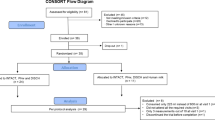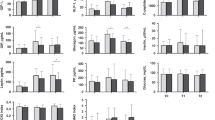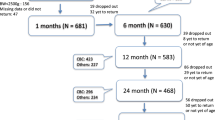Abstract
Background/Objectives:
Milk increases both fasting insulin and insulin-like growth factor 1 (IGF-1), and thereby growth, in healthy prepubertal boys. It is, however, unknown which components in milk are responsible for milk's growth-stimulating effect.
Subjects/Methods:
To get closer to the identification of which components in milk that stimulate growth, we have performed an intervention study with 57 eight-year-old boys in which we examined the effects of the two major milk protein fractions, whey and casein, and milk minerals (Ca and P) in a 2 × 2 factorial design on IGFs and glucose–insulin metabolism. The amounts of whey and casein were identical to the content in 1.5 l skim milk. The amounts of Ca and P were similar to 1.5 l skim milk in the high-mineral drinks, whereas the amounts of Ca and P were reduced in the low-mineral drinks.
Results:
There were no interactions between milk mineral groups (high, low) and milk protein groups (whey, casein). Serum IGF-1 increased by 15% (P<0.0001), whereas there was no change in fasting insulin (P=0.36) in the casein group. In the whey group, fasting insulin increased by 21% (P=0.006), with no change in IGF-1 (P=0.27). There were no independent effects of a high milk mineral intake on IGF-1 and insulin.
Conclusions:
The main milk protein fractions exhibit important but different growth-promoting effects by increasing either fasting insulin (whey) or IGF-1 (casein) levels.
This is a preview of subscription content, access via your institution
Access options
Subscribe to this journal
Receive 12 print issues and online access
$259.00 per year
only $21.58 per issue
Buy this article
- Purchase on Springer Link
- Instant access to full article PDF
Prices may be subject to local taxes which are calculated during checkout
Similar content being viewed by others
References
Amiel SA, Sherwin RS, Hintz RL, Gertner JM, Press CM, Tamborlane WV (1984). Effect of diabetes and its control on insulin-like growth factors in the young subject with type I diabetes. Diabetes 33, 1175–1179.
Axelsson I, Borulf S, Raiha N (1987). Protein intake during weaning. II. Metabolic responses. Acta Paediatr Scand 76, 457–462.
Azadbakht L, Mirmiran P, Esmaillzadeh A, Azizi F (2005). Dairy consumption is inversely associated with the prevalence of the metabolic syndrome in Tehranian adults. Am J Clin Nutr 82, 523–530.
Bleicher M, Hogel J, Wudy S, Wabitsch M, Homoki J, Sorgo W et al. (2002). Insulin resistance (HOMA) in relation to plasma cortisol, IGF-I and IGFBP-3. A study in normal short-statured and GH-deficient children. Horm Res 58, 229–232.
Chan JM, Stampfer MJ, Giovannucci E, Gann PH, Ma J, Wilkinson P et al. (1998). Plasma insulin-like growth factor-I and prostate cancer risk: a prospective study. Science 279, 563–566.
Choi HK, Willett WC, Stampfer MJ, Rimm E, Hu FB (2005). Dairy consumption and risk of type 2 diabetes mellitus in men: a prospective study. Arch Intern Med 165, 997–1003.
Cole TJ, Bellizzi MC, Flegal KM, Dietz WH (2000). Establishing a standard definition for child overweight and obesity worldwide: international survey. BMJ 320, 1240–1243.
Devine A, Rosen C, Mohan S, Baylink D, Prince RL (1998). Effects of zinc and other nutritional factors on insulin-like growth factor I and insulin-like growth factor binding proteins in postmenopausal women. Am J Clin Nutr 68, 200–206.
Dorup I, Flyvbjerg A, Everts ME, Clausen T (1991). Role of insulin-like growth factor-1 and growth hormone in growth inhibition induced by magnesium and zinc deficiencies. Br J Nutr 66, 505–521.
Estivariz CF, Ziegler TR (1997). Nutrition and the insulin-like growth factor system. Endocrine 7, 65–71.
Fomon SJ (1993). Protein. In: Fomon SJ (ed). Nutrition of Normal Infants. Mosby: St Louis, MO, pp 121–146.
Giovannucci E, Pollak M, Liu Y, Platz EA, Majeed N, Rimm EB et al. (2003). Nutritional predictors of insulin-like growth factor I and their relationships to cancer in men. Cancer Epidemiol Biomarkers Prev 12, 84–89.
Giovannucci E, Pollak MN, Platz EA, Willett WC, Stampfer MJ, Majeed N et al. (2000). A prospective study of plasma insulin-like growth factor-1 and binding protein-3 and risk of colorectal neoplasia in women. Cancer Epidemiol Biomarkers Prev 9, 345–349.
Hankinson SE, Willett WC, Colditz GA, Hunter DJ, Michaud DS, Deroo B et al. (1998). Circulating concentrations of insulin-like growth factor-I and risk of breast cancer. Lancet 351, 1393–1396.
Holmes MD, Pollak MN, Willett WC, Hankinson SE (2002). Dietary correlates of plasma insulin-like growth factor I and insulin-like growth factor binding protein 3 concentrations. Cancer Epidemiol Biomarkers Prev 11, 852–861.
Hoppe C, Andersen GS, Jacobsen S, Molgaard C, Friis H, Sangild PT et al. (2008). The use of whey or skimmed milk powder in fortified blended foods for vulnerable groups. J Nutr 138, 145S–161S.
Hoppe C, Mølgaard C, Juul A, Michaelsen KF (2004a). High intakes of skimmed milk, but not meat, increase serum IGF-I and IGFBP-3 in eight-year-old boys. Eur J Clin Nutr 58, 1211–1216.
Hoppe C, Mølgaard C, Michaelsen KF (2006). Cow's milk and linear growth in industrialized and developing countries. Ann Rev Nutr 26, 131–173.
Hoppe C, Mølgaard C, Vaag A, Barkholt V, Michaelsen KF (2005). High intakes of milk, but not meat, increase s-insulin and insulin resistance in 8-year-old boys. Eur J Clin Nutr 59, 393–398.
Hoppe C, Udam TR, Lauritzen L, Mølgaard C, Juul A, Michaelsen KF (2004b). Animal protein intake, serum insulin-like growth factor I, and growth in healthy 2.5-y-old Danish children. Am J Clin Nutr 80, 447–452.
Johnson TR, Blossey BK, Denko CW, Ilan J (1989). Expression of insulin-like growth factor I in cultured rat hepatocytes: effects of insulin and growth hormone. Mol Endocrinol 3, 580–587.
Juul A, Scheike T, Davidsen M, Gyllenborg J, Jorgensen T (2002). Low serum insulin-like growth factor I is associated with increased risk of ischemic heart disease: a population-based case-control study. Circulation 106, 939–944.
Kalkwarf HJ, Khoury JC, Lanphear BP (2003). Milk intake during childhood and adolescence, adult bone density, and osteoporotic fractures in US women. Am J Clin Nutr 77, 257–265.
Ma J, Giovannucci E, Pollak M, Chan JM, Gaziano JM, Willett W et al. (2001). Milk intake, circulating levels of insulin-like growth factor-I, and risk of colorectal cancer in men. J Natl Cancer Inst 93, 1330–1336.
Ma J, Pollak MN, Giovannucci E, Chan JM, Tao Y, Hennekens CH et al. (1999). Prospective study of colorectal cancer risk in men and plasma levels of insulin-like growth factor (IGF)-I and IGF-binding protein-3. J Natl Cancer Inst 91, 620–625.
Matthews DR, Hosker JP, Rudenski AS, Naylor BA, Treacher DF, Turner RC (1985). Homeostasis model assessment: insulin resistance and beta-cell function from fasting plasma glucose and insulin concentrations in man. Diabetologia 28, 412–419.
Moorman PG, Terry PD (2004). Consumption of dairy products and the risk of breast cancer: a review of the literature. Am J Clin Nutr 80, 5–14.
Newmark HL, Wargovich MJ, Bruce WR (1984). Colon cancer and dietary fat, phosphate, and calcium: a hypothesis. J Natl Cancer Inst 72, 1323–1325.
Ninh NX, Thissen JP, Collette L, Gerard G, Khoi HH, Ketelslegers JM (1996). Zinc supplementation increases growth and circulating insulin-like growth factor I (IGF-I) in growth-retarded Vietnamese children. Am J Clin Nutr 63, 514–519.
Olchovsky D, Bruno JF, Wood TL, Gelato MC, Leidy Jr JW, Gilbert Jr JM et al. (1990). Altered pituitary growth hormone (GH) regulation in streptozotocin-diabetic rats: a combined defect of hypothalamic somatostatin and GH-releasing factor. Endocrinology 126, 53–61.
Ostman EM, Liljeberg Elmstahl HG, Bjorck IM (2001). Inconsistency between glycemic and insulinemic responses to regular and fermented milk products. Am J Clin Nutr 74, 96–100.
Pereira MA, Jacobs Jr DR, Van Horn L, Slattery ML, Kartashov AI, Ludwig DS (2002). Dairy consumption, obesity, and the insulin resistance syndrome in young adults: the CARDIA Study. JAMA 287, 2081–2089.
Rogers I, Emmett P, Gunnell D, Dunger D, Holly J (2006). Milk as a food for growth? The insulin-like growth factors link. Public Health Nutr 9, 359–368.
Ruel MT (2003). Milk intake is associated with better growth in Latin America: evidence from the demographic and health surveys. FASEB J 17, A1199.
Slaughter MH, Lohman TG, Boileau RA, Horswill CA, Stillman RJ, Van Loan MD et al. (1988). Skinfold equations for estimation of body fatness in children and youth. Hum Biol 60, 709–723.
Tanner JM, Whitehouse RH (1975). Revised standards for triceps and subscapular skinfolds in British children. Arch Dis Child 50, 142–145.
van der Pols JC, Bain C, Gunnell D, Smith GD, Frobisher C, Martin RM (2007). Childhood dairy intake and adult cancer risk: 65-y follow-up of the Boyd Orr cohort. Am J Clin Nutr 86, 1722–1729.
Acknowledgements
We thank Birgitte Hermansen, Vivian Anker and Marianne Støckel for their valuable help with the study. Also, we thank Arla Food Ingredients for designing, producing and sponsoring the milk drinks. The study was funded by a grant from the Danish Research Agency (FELFO). The authors (CH, CM and KFM) designed the study and were responsible for the collection of data (CD, CM and KFM). CH was responsible for analysis of data and writing of the article. All authors participated in the discussion of the results and revision of the article. CH, CM and KFM have received research grants from the Danish Dairy Research Foundation to perform research on milk and growth. The milk-based drinks were manufactured and donated by ARLA Foods Ingredients a.m.b.a.
Author information
Authors and Affiliations
Corresponding author
Additional information
Conflict of interest
The authors declare no conflict of interest.
Rights and permissions
About this article
Cite this article
Hoppe, C., Mølgaard, C., Dalum, C. et al. Differential effects of casein versus whey on fasting plasma levels of insulin, IGF-1 and IGF-1/IGFBP-3: results from a randomized 7-day supplementation study in prepubertal boys. Eur J Clin Nutr 63, 1076–1083 (2009). https://doi.org/10.1038/ejcn.2009.34
Received:
Revised:
Accepted:
Published:
Issue Date:
DOI: https://doi.org/10.1038/ejcn.2009.34
Keywords
This article is cited by
-
The Role of Cow’s Milk Consumption in Breast Cancer Initiation and Progression
Current Nutrition Reports (2023)
-
The skeletal safety of milk-derived proteins: A meta-analysis of randomized controlled trials
Osteoporosis International (2023)
-
Impact of whole dairy matrix on musculoskeletal health and aging–current knowledge and research gaps
Osteoporosis International (2020)
-
Der Einfluss westlicher Ernährung
Der Deutsche Dermatologe (2019)
-
Postprandial metabolic responses to ingestion of bovine glycomacropeptide compared to a whey protein isolate in prediabetic volunteers
European Journal of Nutrition (2019)



